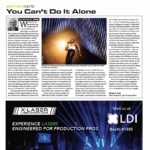As a lighting designer, I just love my software. I know a lot of designers who whine about drawing plots and having to number things. They’d rather shout directions out to some assistant who can scribble notes now and transform that into 2D plots, 3D renderings and paperwork on how to make it all work. I get all that, and there’s nothing wrong with it. But I am not that guy. I am addicted to my software and would rather do it all myself.
From Functional to Fancy
As an editor, most of my software comes from Microsoft Office. Or Mac programs like Final Cut Pro. It’s all useful, everyday stuff necessary for my daytime job. But it doesn’t get my blood flowing like the plethora of products out there designed to help out my nighttime job. There are many CAD programs with plug-ins designed to make basic light plots. Then you have programs designed to turn your 2D drawings into 3D models. From there, you can export those 3D models into amazing software programs that can turn your stage ideas into gorgeous visual renderings. Or import them into a previz program where one can attach a lighting console and actually program a show days before you are on site. Then, of course, we have programs that just spit out all the necessary paperwork, from fixture counts to truss weights to circuiting.
Nowadays, there are certain software companies that can do all of the above. But to buy a complete program that can do all of that may just set you back five large ($5,000). And you may not need it all. My first drawing software was on a Mac using a simple program called MacDraw. Candace Brightman of the Grateful Dead was using this cool new stuff called email to send our light shop CAD drawings of the next light plot. I imported her plot and figured out how it all worked pretty quickly. It was cumbersome, but beat using a stencil and graph paper.
Around 1995 I chipped in with some guys and spent $1,200 total for MiniCad 6 and a cool program called LD Assistant. We just needed a cool way to draw up 2D light plots, and this was the most affordable way. Nobody thought twice back then about having the same software copy on different computers. We chose MiniCad because it was cheaper than AutoCAD and had plug-ins that gave us all the symbols we needed. Eventually, we learned how to draw in 3D, and MiniCad became Vectorworks. Around 1996, a friend named Nils Thorjussen stopped by my house with a new product. He hooked up his Whole Hog lighting console to a computer with some sort of dongle. The next thing you know, I was looking at a monitor with colored lines (representing moving light beams) wiggling around. It was the birth of pre-visualization in the lighting world.
Price and Performance
The cool thing about today’s lighting software is the packaging, bundles and subscriptions the different companies have. Do your homework, starting with this month’s Buyers Guide on LD software (pages 34-35). You may just want an easy CAD program that can figure out truck packs and make basic 2D light plots. For around $100 you can buy basic TurboCAD and you are on your way. More and more people are turning to SketchUp, a program that Google once offered but now costs a little over 500 clams. You can turn light beams on and show stage designs from all sorts of camera views. Vectorworks is still a simple-to-learn program, and probably the most common CAD program used in the entertainment field today.
Most of these companies have Light versions of their software. For instance, I could never afford the $4K to buy AutoCAD. But I found AutoCAD Light could do everything I needed, and it only cost $1,200. Same thing applies with paperwork. Cinema 4D, WYSIWYG and Light Converse, for example, come in several packages. If you want the full package, all of these will set you back some serious coin, but if you just want to draw a light plot with paperwork and not make pretty movie files or previz your show, you can do that for a fraction of the price. Lightwright is a great program for organizing all your show’s paperwork. But it’s not designed to draw plots itself.
Some companies have a basic purchase price and, after a certain period, the user must pay a yearly subscription fee that covers new symbols, online help or even personal assistance. Some companies such as Martin Show Designer have given up on basic pricing and just run an affordable yearly subscription plan. Others have no subscription, but once you buy the software, you have free support for life. Lastly, almost every company has a student plan where you can buy the software for half price or less at times. So no matter who you are in the lighting biz, there is something helpful for you in this month’s Buyers Guide. Turn to pages 34-35 for more details.


